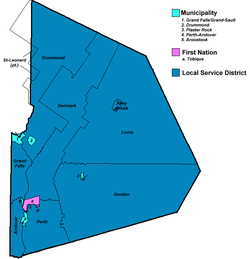Victoria | |
|---|---|
 Location within New Brunswick. | |
| Country | Canada |
| Province | New Brunswick |
| Established | 1844 |
| Shire town | Perth-Andover |
| Area | |
| • Land | 5,492.85 km2 (2,120.80 sq mi) |
| Population (2021) [2] | |
• Total | 18,312 |
| • Density | 3.3/km2 (8.5/sq mi) |
| • Change 2016-2021 | |
| • Dwellings | 9,054 |
| Time zone | UTC-4 (AST) |
| • Summer (DST) | UTC-3 (ADT) |
| Area code | 506 |

Victoria County (2021 population 18,312 [2] ) is located in northwestern New Brunswick, Canada. Farming, especially of potatoes, is the major industry in the county. The area was named for Queen Victoria. [3]